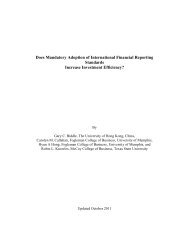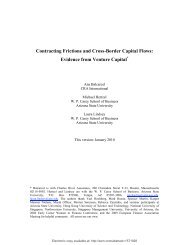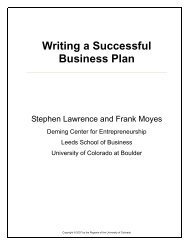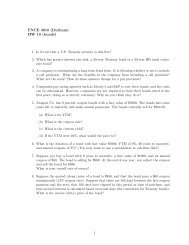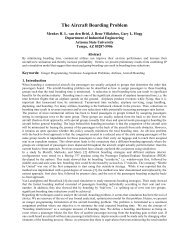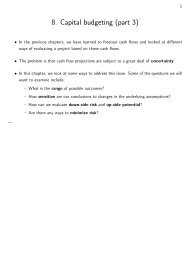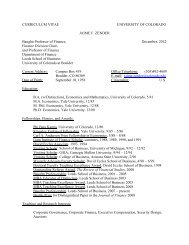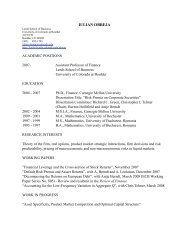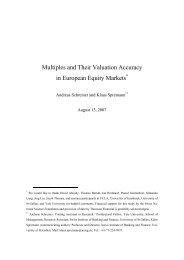Feasibility Study - Looking for something?
Feasibility Study - Looking for something?
Feasibility Study - Looking for something?
Create successful ePaper yourself
Turn your PDF publications into a flip-book with our unique Google optimized e-Paper software.
<strong>Feasibility</strong> <strong>Study</strong><br />
Horizonless Solutions<br />
Andrew Gano<br />
Shane Nowell<br />
Aaron Roth
Table of Contents<br />
• PART III: VENTURE ANALYSIS<br />
• APPENDIX<br />
• Part I INDUSTRY & MARKET ANALYSIS<br />
• Part II COMPETITIVE ANALYSIS<br />
• EXHIBITS
Venture Analysis<br />
Horizonless Solutions
Table of Contents – Part III<br />
• VENTURE ANALYSIS<br />
• Opportunity<br />
• Product<br />
• Target Market<br />
• Unique Benefits<br />
• Competitive Advantage<br />
• Risks<br />
• Financials<br />
• Conclusions
Opportunity<br />
• Problem<br />
• In person tours are<br />
• Costly<br />
• Inconsistent<br />
• Inflexible<br />
• Standard<br />
• Compelling Need<br />
• A solution that offers<br />
• flexible,<br />
• cost effective,<br />
• personalized, and<br />
• interactive<br />
• touring service to increase<br />
1. number of visits<br />
2. revenue per visitor
Product – Overview<br />
• An interactive touring solution delivered via an electronic<br />
handheld device with the following features:<br />
• Multi-media content: text/pictures/audio/video<br />
• Location sensitive content prompting and delivery<br />
• Customized tours based on duration, interest, and audience<br />
• 24/7 availability<br />
• Horizonless Solutions will enable implementation through the<br />
following service offerings:<br />
• Interactive content creation, translation, import and management<br />
• Device customization and deployment<br />
• Wireless Network configuration/integration<br />
• Application development and deployment<br />
• Training, service and business model development
Product - User Experience<br />
Current tour stop and<br />
recommended next stop<br />
Headphones <strong>for</strong><br />
enriching audio<br />
experience<br />
Video selection of<br />
historic and relevant<br />
events and scenes or<br />
interest, etc<br />
Photo viewing <strong>for</strong> site<br />
identification, various<br />
seasons, events, views, etc<br />
Relevant Map and<br />
highlighted location<br />
Background in text and<br />
audio narrative
Product – Additional Features<br />
• From End-User Survey:
Product – Offering Elements<br />
Per<strong>for</strong>mance<br />
Multimedia<br />
Interactive<br />
Engaging<br />
Personalized<br />
Implementation<br />
Consultative approach<br />
Fully supported<br />
Turnkey ef<strong>for</strong>t<br />
Service<br />
Availability/Reliability<br />
24/7<br />
95% System Uptime<br />
99.9% Device Survival Rate<br />
9-5 M-F<br />
1-800 support (Silver)<br />
In person support (Gold)<br />
24 hour resolution<br />
Cost<br />
To implement: ~100-200K<br />
To maintain: $2-3 per touring day<br />
Ease of Use<br />
Easy to tour and navigate<br />
Easy to manage and<br />
check-in/check-out<br />
Easy to update content
Product - Business Models<br />
• Two partnership models are available to fund the implementation<br />
and maintenance of the service<br />
• Consumer Direct Model<br />
• Horizonless will pursue opportunities direct to consumer where touring value<br />
proposition is robust but the related business organization cannot manage it<br />
• National Parks, Towns and Cities<br />
• Business Buyer Model<br />
• Horizonless will let the business re-sell their service where touring proposition is less<br />
robust, but benefits to business are high<br />
• Attractions, Corporations, Universities, Hotels<br />
Who funds the service<br />
Who pays <strong>for</strong> implementation<br />
Who manages the service<br />
Who assumes Risk<br />
Who manages billing<br />
Who markets and promotes<br />
Who gets most of the upside<br />
Who gets a royalty<br />
Business Buyer Model<br />
Business, with offsetting fees<br />
Business<br />
Business<br />
Business<br />
Business<br />
Business<br />
Business<br />
Horizon less<br />
Consumer Direct Model<br />
Consumer<br />
Horizon less<br />
Horizon less<br />
Horizon less<br />
Horizon less<br />
Joint<br />
Horizon less<br />
Business
Product - System Overview<br />
Content System<br />
Touring System<br />
1. Existing and new audio and video<br />
content is uploaded into the tour using<br />
standard input devices<br />
2. Horizonless’ proprietary tour content<br />
management application translates all<br />
media into appropriate <strong>for</strong>mats and<br />
integrates in into the tour<br />
3. All application and content versions is<br />
stored in a database that is periodically<br />
syned with “docked touring devices”<br />
4. The end user “checks out” the touring<br />
device which is location aware with the<br />
assistance of a wireless network<br />
5. The touring device recognizes content<br />
applicable “hot spots” and prompts the<br />
user to view and listen to multimedia<br />
content
Product - Network Plat<strong>for</strong>m<br />
Position Determination<br />
User Entered<br />
GPS<br />
RFID Tags<br />
802.11 WAP<br />
Cell Tower<br />
Content Source<br />
Internal<br />
Storage<br />
802.11<br />
WAPs<br />
Cell<br />
Towers<br />
Advantages: Free<br />
network, cheap<br />
handheld, high<br />
positional accuracy,<br />
Disadvantages: poor<br />
customer experience,<br />
no real-time content<br />
Advantages: free<br />
network.<br />
Disadvantages:<br />
outdoors only, low<br />
positional accuracy, no<br />
real time content<br />
Advantages: cheap<br />
network<br />
Disadvantages:<br />
indoors only, very<br />
limited range<br />
Advantages: high<br />
positional accuracy,<br />
indoors and outdoors,<br />
real-time content<br />
Disadvantages:<br />
short range, network<br />
maintenance costs.<br />
Advantages: Many<br />
Users, real-time<br />
content<br />
Disadvantages:<br />
contracting barriers,<br />
high cost, low<br />
coverage in parks<br />
Satellites<br />
Advantages:<br />
nationwide coverage,<br />
real-time content<br />
Disadvantages: :<br />
Contracting barriers,<br />
high cost, large<br />
handheld, outside-only
Product - Range vs. Accuracy<br />
High<br />
User Entered<br />
Satellite<br />
Good!<br />
GPS<br />
Network<br />
Range<br />
Cell Towers<br />
802.11<br />
Low<br />
Poor!<br />
RFID Tags<br />
Low Ease / Accuracy of Position Determination<br />
High
Product - Network Plat<strong>for</strong>m Conclusions<br />
• User determined position – internally stored content<br />
• Description: User enters position by reading tag and manually typing a number into the mobile device. Manual device accesses<br />
content from internal memory.<br />
• Rejected Users do not want to enter the position manually.<br />
• RFID tag determined position – internally stored content<br />
• Description: Mobile device determines position via proximity to RFID tags. Mobile device accesses content from internal<br />
memory.<br />
• Narrowly Applicable Not generally useable <strong>for</strong> wide range touring, but possibly useful in museums with specific points of<br />
interest.<br />
• GPS Position – internally stored content<br />
• Description: Mobile device determines position via GPS. Device accesses content from internal memory.<br />
• Promising Although data cannot be updated in real-time, GPS will work throughout the world <strong>for</strong> free.<br />
• 802.11 position / data<br />
• Description: Mobile device determines position via 802.11 triangulation. Device accesses content from internal memory.<br />
• Promising Although network distances are short, 802.11 works well inside and offers real-time data or application changes.<br />
• Cell tower position / data<br />
• Description: Mobile device receives position and content data from cell towers.<br />
• Rejected Using cell towers would require the difficult task of negotiating favorable deals with cell operators.<br />
• GPS position / satellite data<br />
• Description: Mobile device receives position in<strong>for</strong>mation from GPS satellites, and content in<strong>for</strong>mation through special purpose<br />
satellites such as Onstar.<br />
• Rejected Not enough user-benefit to justify cost and complexity over GPS – internally stored data.<br />
GPS Positioning with internally stored content represents the most promising long<br />
range / outdoors solution.<br />
802.11 Positioning and Content distribution represents the most promising short<br />
range / indoors solution.
Product - Device<br />
Desirable Features<br />
Light<br />
Small<br />
Rugged<br />
Inexpensive<br />
Large color screen<br />
Ergonomic interface<br />
Powerful enough <strong>for</strong> application<br />
802.11 and / or GPS enabled<br />
External Memory Slot<br />
10 hour rechargeable battery<br />
Sound Capability<br />
Camera<br />
Standardized programming interface<br />
No GPS<br />
Too Big<br />
A GPS-enabled / 802.11-<br />
enabled PDA represents<br />
the best compromise<br />
between price, usability,<br />
and versatility.<br />
Proprietary Data<br />
Network
Product - Content<br />
Definition<br />
Base Content<br />
Content which would be normally included in an<br />
ordinary mapping application.<br />
Special Content<br />
Content unique to our touring application<br />
Examples<br />
Sources<br />
streets, contour lines, mountain names, rivers, and<br />
lakes.<br />
Movies, pictures, trail maps, sounds, etc.<br />
We will have to develop this ourselves,<br />
or pay to have it developed.<br />
Expected<br />
expense<br />
Navteq or GDT through license<br />
Low up front costs with ongoing reasonable fees on<br />
a per mobile device basis.<br />
Very high up-front development or purchase costs, but<br />
no licensing fees.
Product - Application<br />
For purposes of this slide, application shall be defined as the software means by which the content data get displayed on<br />
the mobile device in a way that is useful to the user. Content data is the aggregate of the base data and special data<br />
described on the previous slide.<br />
Base Content<br />
User Inputs<br />
Special Content<br />
Position data<br />
Application<br />
Experience<br />
Considerations<br />
1. Portability to other network plat<strong>for</strong>ms.<br />
2. Portability to other mobile device plat<strong>for</strong>ms.<br />
3. Scalability of geographic breadth of<br />
application.<br />
4. Expandability to new uses<br />
5. Ease of Development<br />
6. Cost of Development<br />
7. Cost of use<br />
8. Time to Market<br />
9. Profitability<br />
• Two application development strategies<br />
• Develop our own<br />
• License<br />
• Difficult; probably at least 3 programmers by one year to develop a<br />
crude application.<br />
• Risky; could turn into a rat hole <strong>for</strong> very expensive startup capital<br />
• Easy; turnkey solutions are available from several vendors.<br />
• Could be expensive in the long run due to licensing fees.<br />
Despite the long-term potential financial<br />
impact of licensing fees, a turnkey solution<br />
should be strongly considered because of the<br />
low risk and upfront costs.
Target Markets: Colleges<br />
• Description<br />
• Large public and private college/university campus >5000 students<br />
• University of Denver, University of Colorado, Naropa University<br />
• Organization<br />
• Each college has an office of admissions, under which a campus touring functions operate with 2-3 FTE<br />
• Most touring functions have a lead coordinator, with 2-3 administrators and a large staff of student volunteers<br />
• Product Perception<br />
• No early adopters, this market views the technology as very advanced, and is only now slowly adopting the internet<br />
<strong>for</strong> core processes<br />
• Buyers in this segment views technology as “impersonal” and hence inferior to in-person tours<br />
• Sales Process<br />
• Buyer: Touring coordinator makes a recommendation to the director of admissions, who makes the purchase<br />
decision, even down to 5-10K<br />
• Budget: Office of admissions, which is constantly under pressure and being reduced<br />
• Sales Cycle: 1 year +, very slow bureaucratic decision making, further time <strong>for</strong> implementation<br />
• Decision Criteria<br />
• The primary criteria is does this technology or service:<br />
• A) Increase the number of applicants or acceptances by prospective students<br />
• B) Increase in quality of applicants or acceptances of prospective students<br />
• Payment Policy<br />
• Standard Net 30 days, no discount<br />
• Channel<br />
• Direct selling<br />
• Some potential channel partners in admission software or video companies<br />
• Conclusions<br />
• Must be private or well funded University – could be a direct to consumer play via a Kiosk, in-person student tours<br />
are a powerful competitor
Target Markets: Corporate<br />
• Description<br />
• Fortune 500 companies with large campus/facilities and many employees on-boarding each month<br />
• Employee focused company, “Best Places to Work” = does not view HR as a cost center<br />
• Storage Tex Sun Microsystems, IBM, Qwest<br />
• Organization<br />
• Headquarters will have a centralized Human Resource organization that is responsible <strong>for</strong> orienting/on-boarding<br />
new hires, they then distribute the process and responsibilities to in a distributed fashion, where managers and<br />
mentors take responsible <strong>for</strong> various sections of the orientation<br />
• Product Perception<br />
• For companies that are looking to appear technologically advanced perceive the product as a positive employee<br />
relations move<br />
• For companies that also have lots of customers visiting and want to make a similar positive impression<br />
• Sales Process<br />
• Buyer: VP of HR or Customer Service<br />
• Sales Cycle: 3-6 months <strong>for</strong> sell-in approval, further time <strong>for</strong> implementation<br />
• Sales Hit Rate: Low percentage of buyers compared to prospects<br />
• Decision Criteria<br />
• The primary criteria is does this technology or service improve “employee morale” and/or “time to productivity”<br />
• Payment Policy<br />
• Standard Net 30 days, no discount<br />
• Channel<br />
• Direct selling<br />
• Conclusion<br />
• Not an attractive Market, value proposition just not compelling enough – too few companies view HR as strategic or<br />
have campuses large enough, no user-based pay/purchase business model available; pursue opportunistically
Target Markets: Attractions<br />
• Description<br />
• Popular tourist attractions such as zoos, aquariums, stadiums, and museums that have a rich variety of available<br />
content, and a large geographic space<br />
• Invesco Field, Denver Zoo, Denver Aquarium<br />
• Organization<br />
• The Executive Director normally has a head of customer service that manages the visitor experience.<br />
• Product Perception<br />
• Very receptive, have other similar products in use.<br />
• Sales Process<br />
• Buyer: A purchase this large will most likely need to be approved by the Executive Director or CEO of the relevant<br />
attraction<br />
• Decision Criteria<br />
• The primary criteria is does this technology or service:<br />
• Payment Policy<br />
• A) increase ticket sales due to direct marketing examples<br />
• B) Provide additional desperately needed revenue<br />
• C) Improve visitor experience and resulting word of mouth<br />
• Standard Net 30 days, no discount<br />
• Channel<br />
• Direct selling
Target Markets: Parks<br />
• Description<br />
• In the order of priority, National, State, and local parks with rich content, history and large visit numbers/budget<br />
1,000,000 annual visits plus+<br />
• Rocky Mountain National Park (3M), Yellowstone National Park (30M)<br />
• Organization<br />
• Each park is run by a superintendent and assistance superintendent that holds control over their local park budget<br />
• Each park reports back to the national organization, which hold significant sway over practices and technologies<br />
• Each park has a “gateway city” where this service could be marketed and sold<br />
• Product Perception<br />
• Parks prefer traditional methods to management and are general slow to adopt new technology<br />
• They would perhaps help us with promotion but not directly own or operate the technology<br />
• Sales Process<br />
• Buyer: A purchase this radical will most likely need a park superintendent to advocate <strong>for</strong> the technology, and then<br />
the national park office to approve its use<br />
• Budget: Each park has a sizeable budget from 500,000 (Charles Pinckney) to 30,000,000 (Yellowstone)<br />
• Sales Cycle: Could be as long as 1-2 years <strong>for</strong> the slow moving, cash strapped organization<br />
• Decision Criteria<br />
• The primary criteria is does this technology or service:<br />
• A) Improve visitor access and experience<br />
• B) Provide additional desperately needed revenue<br />
• Payment Policy<br />
• Standard Net 30 days, no discount<br />
• Channel<br />
• Direct selling<br />
• Conclusion<br />
• Different Sales Approach: we may direct sale to the consumer in these cases, the Parks are not a feasible customer<br />
but have large visitor numbers and access to them
Target Markets: Hotels<br />
• Description<br />
• Large middle/upper market hotels in urban areas<br />
• Boulderado, Adam’s Mark Hotel, Hotel Teatro<br />
• Organization<br />
• Assistant general managers typically work with vendors, review proposals, and submit recommendations to<br />
the hotel general manager. General manager/owners make final purchasing decisions.<br />
• Product Perception<br />
• Hotels liked the ability to deliver guests an activity list based upon gender, age, and interests. Upper market<br />
hotels were concerned this service would conflict with their philosophy of personal service by cutting the<br />
concierge out of the loop. Hotels managers thought guests would prefer concierge recommendations<br />
because they are unbiased opinions. Many managers suggested integration with existing hotel software to<br />
enhance the service.<br />
• Sales Process<br />
• Buyer: Owner or hotel manager<br />
• Budget: Budget range depends on hotel size ($100,000 - $2,000,000)<br />
• Sales Cycle: 3-6 months <strong>for</strong> hardware/software vendors.<br />
• Decision Criteria:<br />
• Clearly fulfills a need <strong>for</strong> a hotel guests<br />
• Provides a clear benefit to the hotel (online internet access with a cordless keyboard)<br />
• Length of installation process. Does it work with existing hotel software<br />
• How obtrusive is the technology or device within the hotel room or hotel lobby<br />
• The primary criteria is does this technology or service:<br />
• A) Improve visitor access and experience<br />
• B) Provide additional desperately needed revenue<br />
• Payment Policy<br />
• 1% 10, Net 30<br />
• Channel<br />
• Path of least resistance is to integrate with existing hotel software (Fidelio) or telco (Coax Media) provider<br />
• Direct selling
Target Markets: Municipalities<br />
• Description<br />
• Large to mid-sized cities that draw large crowds of tourists<br />
• Denver Bureau of Tourism, Metro Denver Convention and Visitors Bureau, Denver and Boulder Chamber of<br />
Commerce<br />
• Organization<br />
• Bureau’s are typically run by a director and assistant director.<br />
• Buying decisions are typically driven by local business needs<br />
• Product Perception<br />
• Municipalities thought highly of the concept because they saw it as increasing the equity value of the municipalities<br />
brand. Generating awareness around the municipalities unique historical areas and driving more people to come<br />
downtown to spend money at local businesses was a plus. The Metro Denver Convention and Visitors Bureau as<br />
well as the Denver Bureau of Tourism represent the most likely potential customers.<br />
• Sales Process<br />
• Buyer:<br />
• Written proposals are typically reviewed by the assistant director or director<br />
• Recommendations are passed along to a broader committee or board<br />
• Budget: Depends on city size ($5.4M <strong>for</strong> the Denver Bureau of Tourism)<br />
• Sales Cycle: 3-4 months.<br />
• Decision Criteria<br />
• The primary criteria is does this technology or service:<br />
• Bring more people downtown to shop and gain exposure to the city<br />
• For those already downtown, does it enhance their perception of the municipality<br />
• Does it increase the sales <strong>for</strong> local businesses<br />
• Payment Policy<br />
• Standard Net 30 days, no discount.<br />
• Channel<br />
• Direct selling, buzz/word-of-mouth through influential members of local business community.
Target Market - End-User Feedback<br />
1City<br />
2 College<br />
3 Attraction<br />
4Town<br />
5Park<br />
6 Stadium<br />
7 Company<br />
8Hotel<br />
Markets ranked<br />
from most likely to<br />
least likely to use<br />
the Virtual Tour<br />
Guide<br />
• Why NOT<br />
• Why use the Virtual Tour<br />
Guide
Unique Benefits<br />
Unique Benefit Why Unique Benchmark<br />
Most enriching,<br />
interactive and<br />
personalized,<br />
touring experience<br />
Current offerings<br />
feature only text<br />
(pamphlets), voice<br />
(in-person), pictures<br />
(maps)<br />
A personalized History or<br />
Discovery channel special<br />
on a place with integrated<br />
video, pictures, narrative,<br />
interviews, audio is the our<br />
target experience<br />
Easiest solution to<br />
implement<br />
Current landscape<br />
is filled with<br />
confusing<br />
technology jargon<br />
and companies<br />
A turnkey content<br />
integration experience as<br />
delivered by Advertising<br />
agencies <strong>for</strong> web and print<br />
design – as consultative,<br />
and as turn-key
Competitive Advantage – Substitute Products<br />
From the End user survey…The Virtual Tour Guide vs…<br />
A MAP:<br />
A HUMAN:<br />
A BOOK:
Finance – Business Structure<br />
Prototyping Function<br />
Responsible <strong>for</strong> developing initial prototype application.<br />
Site Creation Function<br />
Responsible <strong>for</strong> integrating content into application <strong>for</strong> a new site.<br />
Responsible <strong>for</strong> hiring initial operating crew <strong>for</strong> a new site<br />
Responsible <strong>for</strong> marketing kickoff of a new site<br />
Corporate Function<br />
Responsible <strong>for</strong> continuing strategic and tactical control of sites and<br />
strategic SCM.<br />
Site Operating Function<br />
Responsible <strong>for</strong> ongoing operational activities such as PDA purchasing,<br />
PDA distribution, PDA preparation, PDA disposal, site management, etc.<br />
Sunk Costs<br />
Fixed and Variable Costs<br />
Corporate<br />
Function Activity<br />
Prototyping<br />
Site Creation<br />
Site 1 Operation<br />
Site Creation<br />
Site 2 Operation<br />
Time
Finance – Corporate, Prototype, and Site Creation Functions<br />
Corporate Function Costs<br />
Management Salary $0<br />
Misc GA $20,000<br />
Total Ongoing costs (per year, fixed) $20,000<br />
Prototyping Function Costs<br />
Programmer Salary, per year $75,000<br />
Programmers required 4<br />
Years required 1<br />
Application Development Software $0<br />
Total Programmer Salary $300,000<br />
Equipment and misc $25,000<br />
Total Prototype Development costs (one time) $325,000<br />
Site Creation Function Costs<br />
Content Acquisition $10,000<br />
Content Integration $10,000<br />
Hiring and Setup $5,000<br />
Total Site Creation Costs $25,000<br />
Ongoing costs <strong>for</strong> General and<br />
Administrative functions.<br />
Costs <strong>for</strong> developing prototype application.<br />
All costs expected to be incurred in first<br />
year.<br />
Costs incurred once with each new<br />
site installation.
Finance – Income Statement - Single Site<br />
Year of operation: Year 1 Year 2 Year 3 Year 4 Year 5<br />
Revenue $67,860 $193,140 $318,420 $375,840 $375,840<br />
(COS - PDAs) ($19,800) ($28,000) ($36,200) ($26,400) ($26,400)<br />
(COS - Wages) ($28,800) ($57,600) ($86,400) ($86,400) ($86,400)<br />
Site Gross Profit (loss) $19,260 $107,540 $195,820 $263,040 $263,040<br />
(Rent) ($12,000) ($12,000) ($12,000) ($12,000) ($12,000)<br />
(Marketing) ($12,000) ($12,000) ($12,000) ($12,000) ($12,000)<br />
(Management) ($24,000) ($24,000) ($24,000) ($24,000) ($24,000)<br />
Site Net Profit (loss) ($28,740) $59,540 $147,820 $215,040 $215,040<br />
Income<br />
statement <strong>for</strong><br />
site<br />
operation<br />
only!<br />
Site Gross Profit Margin 28% 56% 61% 70% 70%<br />
Site Net Profit Margin -42% 31% 46% 57% 57%<br />
Operating Function Assumptions<br />
Price of PDA + Software $200<br />
Employees, per hour $15<br />
PDAs per employee per day 100<br />
Employee duty cycle 5/7<br />
PDAs required per customer 3<br />
Average Rental Price per PDA $15<br />
Customer Pool (per year) 500,000<br />
Market Saturation 5%<br />
Time to Market Saturation, years 3<br />
Destruction rate of PDAs, monthly 5.00%<br />
Rent $1,000<br />
Marketing, per month $1,000<br />
Management, per month $2,000<br />
Hours per day 8<br />
Each Site is expected to<br />
produce an eventual 70% +<br />
Net Profit and 57%+ gross<br />
profit, suggesting fundamental<br />
viability of business model.
Finance – Income Statement<br />
The following combined income statement is <strong>for</strong> a one site operation strategy. It includes all<br />
expected costs, including prototyping, site creation, and corporate overhead.<br />
Year 1 Year 2 Year 3 Year 4 Year 5<br />
Sites to open 0 1 0 1 1<br />
Revenue $0 $67,860 $193,140 $386,280 $636,840<br />
(COS - PDAs) $0 ($19,800) ($28,000) ($56,000) ($74,200)<br />
(COS - Wages) $0 ($28,800) ($57,600) ($115,200) ($172,800)<br />
Site Gross Profit (loss) $0 $19,260 $107,540 $215,080 $389,840<br />
(Rent) $0 ($12,000) ($12,000) ($24,000) ($36,000)<br />
(Marketing) $0 ($12,000) ($12,000) ($24,000) ($36,000)<br />
(Management) $0 ($24,000) ($24,000) ($48,000) ($72,000)<br />
Site Net Profit (loss) $0 ($28,740) $59,540 $119,080 $245,840<br />
(Prototyping costs) ($325,000) $0 $0 $0 $0<br />
(Site Creation costs) $0 ($25,000) $0 ($25,000) ($25,000)<br />
(Corporate Costs) $0 ($20,000) ($20,000) ($20,000) ($20,000)<br />
Total Net Profit (loss) ($325,000) ($73,740) $39,540 $74,080 $200,840
Finance – Break Even Analysis and Funds Required<br />
Break Even Analysis<br />
Year 1 Year 2 Year 3 Year 4 Year 5<br />
Revenue $0 $18,270 $130,500 $255,780 $362,790<br />
Fixed Costs $20,000 $44,000 $68,000 $68,000 $68,000<br />
Variable Costs $0 $23,200 $67,200 $104,000 $118,800<br />
Breakeven Revenues $140,190 $114,594 $101,110<br />
Site Gross Profit Margin 49% 59% 67%<br />
Site Net Profit Margin 12% 41% 54%<br />
Total Net Profit Margin -4% 33% 49%<br />
With a Total Net Profit margin of 49% in year 5, the<br />
business appears feasible.<br />
Break even<br />
revenues <strong>for</strong> years 3<br />
through 5.<br />
Funds Required<br />
Year 1 Year 2 Year 3 Year 4 Year 5<br />
Total Net Profit (loss) ($345,000) ($73,930) ($4,700) $83,780 $175,990<br />
Funds Required $500,000<br />
Cash Available at year end $155,000 $81,070 $76,370 $160,150 $336,140<br />
Because we make little capitalized investment in our model, net income ~=<br />
cashflows. There<strong>for</strong>e, under our assumptions,we need only an initial investment<br />
of $500,000.
Competitive Advantage – Venture Resources and Capabilities<br />
Human<br />
Capabilities<br />
Organizational<br />
Financial<br />
Intangible<br />
•Horizonless’ three founders possess a strong track record of success in<br />
the field of high technology, bringing a wealth of technology product<br />
development and marketing experience to the table. (see bios in appendix<br />
<strong>for</strong> additional detail)<br />
•Andrew Gano – business development, marketing, market<br />
research/analysis<br />
•Shane Nowell – finance, operations, technology management and<br />
implementation<br />
•Aaron Roth – management, product development, user experience<br />
•Through the development of the feasibility plan, Horizonless Tours has<br />
developed a close network of industry contacts and advisors who are<br />
interested in supporting the development of this business<br />
•Primary source of capital: $50,000 cash (Founder’s contribution)<br />
•Secondary sources would rely heavily upon angel investors<br />
•None<br />
Physical Assets<br />
•None
Competitive Advantage – Barriers to Entry<br />
• Current state of the market<br />
• The wireless, interactive tours market has yet to be developed.<br />
• Major players do not currently exist.<br />
• Several start-ups pursuing similar objectives represent new, fast-moving, and<br />
innovative competitors.<br />
• An aggressive response from larger firms who play in related markets (network<br />
operators, handset manufacturers, as well as content and application developers) is<br />
not anticipated due to the fact that Horizonless is pursuing a niche strategy that will<br />
likely fall under their radar.<br />
• Potential barriers to entry<br />
• IP: Horizonless tours plans to patent the interactive touring device and copyright<br />
the company name as means of creating barriers to entry.<br />
• Exclusive agreements: Horizonless Tours plans to pursue an exclusive agreement<br />
strategy with parks, municipalities, and local businesses where Horizonless would<br />
be the exclusive provider of interactive tours <strong>for</strong> that region.<br />
• Customer loyalty: Horizonless’ tours marketing and branding ef<strong>for</strong>ts are expected<br />
to generate customer loyalty that would serve as a barrier of entry.<br />
• Switching costs: are perceived to be very low <strong>for</strong> consumers but much higher <strong>for</strong><br />
businesses.<br />
• Trade secrets: Central to Horizonless’ strategy is the development of a streamlined<br />
process by which content may be pulled from various resources and delivered as an<br />
interactive tour.
Risks<br />
Risk Type<br />
Strategic<br />
Operational<br />
Technological<br />
Level of<br />
Concern<br />
HIGH<br />
HIGH<br />
HIGH<br />
Description<br />
•Horizonless Tours’ adoption projections in financial<br />
models may be unrealistic. Further consumer research<br />
is necessary to mitigate this risk.<br />
•Horizonless’ business model is based upon the ability<br />
the license content from third parties at reasonable<br />
rates. If Horizonless cannot negotiate reasonable rates,<br />
this venture will not be profitable.<br />
•If Horizonless Tours has overestimated its ability to<br />
quickly and cheaply generate an engaging, interactive<br />
touring experience, excessive development costs will<br />
make this venture unprofitable.<br />
•If Horizonless cannot use technology in a way that<br />
easily enables device use without previous training,<br />
consumers will not find the service appealing.<br />
•Horizonless may have underestimated the complexity<br />
of the technology necessary to develop a compelling<br />
offering.
Risks<br />
Risk Type<br />
Competitive<br />
Level of<br />
Concern<br />
MEDIUM<br />
Description<br />
•Existing start-ups may be better positioned to take<br />
advantage of the interactive touring opportunity.<br />
Marketing<br />
Social<br />
LOW<br />
LOW<br />
•Inability to effectively communicate the value<br />
proposition in clear, simple terms, will impede<br />
Horizonless’ ability to acquire customers.<br />
•Consumers may backlash against the use of high<br />
technology in natural areas.<br />
Economic<br />
LOW<br />
•Horizonless’ touring application is seen as an elastic<br />
service highly subject to swings in the economy.<br />
Financial<br />
NONE<br />
•No significant risks identified in this area.<br />
Governmental<br />
NONE<br />
•No significant risks identified in this area.
Conclusions<br />
• Horizonless’ virtual touring application represents a feasible business<br />
Compelling Need<br />
Target Market<br />
Benefits<br />
Competitive<br />
Advantage<br />
Risks<br />
Profit<br />
•Domestic tourism is on the rise<br />
•Tourists are seeking more flexible solutions that accommodate their busy<br />
schedules and offer a unique, enriching touring experience.<br />
•End users have expressed their interest in using such a service, primarily in large<br />
cities<br />
•Municipalities have expressed their interest in purchasing the service.<br />
•The service’s ability to generate an interactive, personalized touring experience<br />
does not currently exist in the U.S.<br />
•Dependent upon Horizonless’ ability to develop an efficient process in the<br />
trans<strong>for</strong>ming current content (text, audio, video) to an enriched touring experience<br />
<strong>for</strong> each point of interest.<br />
•Content acquisition – more research may be per<strong>for</strong>med to better understand the<br />
type of content needed and cost of this content.<br />
•Technology development - prototyping is a cost effective tactic in mitigating the<br />
risk of potential failure of the application to offer a compelling service that is<br />
easily understood by the end user.<br />
•Success is wholly dependent upon Horizonless’ ability to scale this model<br />
•Horizonless believes this concept can generate profit margins of 50% over the<br />
long-term, with ~$200k net profit in year 5.<br />
•$500K is required to start this venture
Recommendations<br />
• In order to pursue this opportunity, Horizonless has identified<br />
the following next steps:<br />
1. Research what types of content are available, potential content<br />
partners, and the associated content costs<br />
2. Conduct in-depth market research to determine the functional<br />
requirements <strong>for</strong> a service targeting tourists in municipalities<br />
3. Work with the University of Colorado’s computer sciences division to<br />
develop a prototype of the service, as a student project, at minimal<br />
cost<br />
4. Write a business that presents a compelling go-to-market strategy<br />
5. Strategically build a board of advisors in order to gain market access<br />
and refine business strategy<br />
6. Acquire seed money to refine the prototype
APPENDIX<br />
Horizonless Solutions
Table of Contents<br />
• APPENDIX<br />
• Part I INDUSTRY & MARKET ANALYSIS<br />
• Part II COMPETITIVE ANALYSIS<br />
• EXHIBITS
Table of Contents - Visual<br />
Horizonless Solutions<br />
Industry<br />
Industry<br />
Segments<br />
Handsets<br />
Applications<br />
Location<br />
Based Services<br />
Solutions Content Networks<br />
Part 1:<br />
Industry<br />
Analysis<br />
Markets<br />
Market<br />
Niches<br />
Logistics Real Estate Touring Agriculture Insurance<br />
Universities Towns Parks Corporate Attractions<br />
Part 2:<br />
Market and<br />
Competitive<br />
Analysis<br />
In this feasibility study, several levels of Horizonless’<br />
industry and market are analyzed, starting with the<br />
highest umbrella industry level and working to more<br />
detailed market niches.
Industry Analysis<br />
Location Based Services (LBS)
Table of Contents - Part I<br />
• INDUSTRY ANALYSIS<br />
• Industry Overview<br />
• Description<br />
• Market Size / Growth<br />
• Trends<br />
• Technological Environment<br />
• Segmentation<br />
• Industry Segments<br />
• Role/Value Proposition<br />
• Customer/Supplier Relationships<br />
• Example Products/Companies<br />
• Relevant Trends<br />
• Structure<br />
• Threats
Industry Description<br />
• Location Based Services<br />
• LBS can be described as "applications, which act according to a<br />
geographic trigger“<br />
• A Geographic Trigger might be the input of a town name, zip code or<br />
street into a web page, the position of a mobile [device] user or the<br />
position of your car as you are driving home from the office<br />
• Using the knowledge of where someone is or where they intend to go<br />
is the essence of LBS<br />
• Technology Elements<br />
• Location-specific content<br />
• A wireless network<br />
• A mobile device<br />
• An interactive application<br />
• A mobile user<br />
Sources: 1- http://www.whereonearth.com/lbs/index.html
Market Size and Growth<br />
Location Based Services<br />
Service<br />
Revenue<br />
$USMil.<br />
(est.)<br />
4000<br />
3500<br />
3000<br />
2500<br />
2000<br />
1500<br />
1000<br />
500<br />
0<br />
2005 2010<br />
Year<br />
Asia-Pacific Europe<br />
North America Rest of World<br />
• LBS will be a large, global<br />
market<br />
• Worldwide service revenue will<br />
be over US$2 Billion by 2005<br />
and near US$10 Billion by 2010<br />
• LBS is an emerging, high<br />
growth industry<br />
• Over 30% CAGR <strong>for</strong> the next 7<br />
years<br />
Sources: UMTS Forum, Telecompetition
Industry Trends<br />
• Mobile devices improving<br />
• Personal Digital Assistants (PDA), Mobile Phones, and other GPS/Wireless<br />
devices are becoming more robust and easier to use<br />
• Enabling technologies commercializing<br />
• Standard operating systems, protocols, and programming libraries<br />
available <strong>for</strong> devices, networks, and applications<br />
• .NET, Pocket PC, Palm, J2ME, WAP, etc<br />
• A hosts of start-up and established companies are commercializing<br />
technology tools such as development suites, GIS plat<strong>for</strong>ms<br />
• MapInfo, MapPoint, Microsoft Location Server<br />
• Easier to acquire a precise real-time location <strong>for</strong> a device<br />
• Technology innovation in both GPS and Wireless spaces<br />
• All mobile handsets locatable by 2005<br />
• Telematics devices highly integrated in all autos by 2005<br />
“The wireless ecosystem is about to be flooded with killer<br />
LBS applications”<br />
Source: Steve Lombardi, Mar 27, 2003. “The Gears Have Been Greased. Mobile Location-Based<br />
Services are ready to roll!”. Directions Magazine
Technological Environment<br />
Geographic In<strong>for</strong>mation<br />
Systems<br />
A set of software, spatial<br />
databases, and protocols<br />
that allows queries based<br />
on geographical position,<br />
map coordinates to<br />
places, and assist in<br />
triangulation and location<br />
processing.<br />
GPS<br />
Supporting<br />
Technologies<br />
A network of 24 radio transmitting<br />
satellites (NAVSTAR) developed by<br />
the US Department of Defense to<br />
provide accurate geographical position<br />
fixing.<br />
Wireless LAN 802.11x<br />
a family of specifications <strong>for</strong><br />
wireless local area networks<br />
(WLANs) developed by<br />
IEEE that enable packetbased<br />
data transfer.<br />
Enhanced 911.<br />
Federal regulations<br />
requiring cell phone<br />
operators to implement<br />
systems that allow 911<br />
dispatchers to locate a cell<br />
phone to within 100 meters.<br />
Personal Digital<br />
Assistants (PDAs)<br />
A family of handheld devices that have<br />
standard operating systems and can<br />
deliver visual, audio, and wireless<br />
interactions to the user
Industry Segmentation<br />
• Primary markets segmentation is Business vs. Consumer<br />
• Several industry segments make up the LBS delivery value chain<br />
• A host of new opportunity in the technology and solution spaces<br />
Solution Providers: Design, Installment, and Services<br />
Business Applications<br />
Content<br />
and<br />
Application<br />
Providers<br />
Network<br />
Operators<br />
Handset<br />
Manufacturers<br />
Technology Enablers: Hardware, Software, Infrastructure<br />
Consumer Applications
Segment Overview: Application Providers<br />
Description<br />
Relationships<br />
Example<br />
Companies<br />
Trends<br />
Structure<br />
Application providers in the LBS space design front end user<br />
interfaces, integrate GIS content, and develop applications to use<br />
GIS data<br />
Customers: Network Operators, Handset Manufacturers,<br />
Automobile Manufacturers, Automobile Rental Firms, Government,<br />
Real Estate, Retail<br />
Suppliers: Software developers<br />
MapInfo, Multimap, TelMap (UK), Autodesk Location Serivces,<br />
Navigation Technologies (digital maps <strong>for</strong> vehicle navigation),<br />
LandMat<br />
•Application providers have been experimenting with providing LBS<br />
to network operators.<br />
•Application providers have close relationships with large<br />
business customers.<br />
No single provider offers 100% geographic coverage.
Segment Overview: Network Operators<br />
Description<br />
Relationships<br />
Example<br />
Companies<br />
Trends<br />
Structure<br />
Network operators install and manage infrastructure that blankets<br />
geographic areas and transmit digital data. Operators purchase<br />
LBS from solution providers and resell them to the end customer.<br />
Customers: Individuals<br />
Suppliers: Application providers, handset manufacturers,<br />
telecommunications equipment manaufacturers<br />
Verizon Wireless, AT&T Wireless, Cingular Wireless, Vodafone Live,<br />
Orange, mmO2 (British mobile operator), US Government<br />
•Network operators are building strong partnerships with LBS<br />
application developers.<br />
•Network operators are building proprietary multichannel and<br />
mobile portals<br />
•U.S. operators will own and control user location data, European<br />
operators own, but cannot disclose user location data<br />
•Mobile Voice and Cellular: Consolidated and national<br />
•Global Positioning Systems: Global and consolidated<br />
•Localized Data Networks: Fragmented
Segment Overview: Handset Manufacturers<br />
Description<br />
Relationships<br />
Example<br />
Companies<br />
Trends<br />
Manufacture hand-held units incorporating GPS, wireless,<br />
computing, and/or cell technology.<br />
Customers: Channel distributors<br />
Suppliers: Electrical and mechanical component suppliers<br />
Garmin, Magellan, Nokia, Samsung, Motorola, Dell<br />
Products: GPS receivers, Cell Phones, PDAs, laptops<br />
Technology and Price Driven<br />
Structure<br />
Mobile Voice and Cellular: Consolidated and National<br />
Global Positioning Systems: Global, and consolidated<br />
Localized Data Networks: highly fragmented
Segment Overview: Solution Providers<br />
Description<br />
Relationships<br />
Example<br />
Companies<br />
Trends<br />
Structure<br />
Solution providers integrate wireless content, applications, and<br />
hardware to provide end-user with wireless, location-based<br />
solutions. Typical functions include application development,<br />
content management, integration, interface design, and billing<br />
management.<br />
Customers: Network operators<br />
Suppliers: Application providers<br />
Webraska Mobile Technologies (Global), Navitime (Japan),<br />
Telcontar (UK)<br />
•Lack of standardized network technology is making it difficult to<br />
leverage scale economies and develop profitable LBS services.<br />
•Most LBS are offered through bundles with other services,<br />
instead of <strong>something</strong> consumers pay <strong>for</strong> separately.<br />
Solution providers include a couple large, multinational<br />
corporations and several dozen small, niche businesses.
Industry Developments<br />
Opportunities<br />
•The broad array of LBS applications provide<br />
ample opportunity <strong>for</strong> niche development.<br />
•Network operators and application<br />
developers are always looking new revenue<br />
streams; LBS niches fall under the radar of<br />
major players.<br />
•Self-guided touring as a low cost vacation<br />
alternative is increasing; Horizonless’<br />
solution can offer an enriched experience at<br />
a reasonable price.<br />
•Most direct competition focuses on the<br />
integration of geo-location and GIS data;<br />
Horizonless can enhance its offering by<br />
integrating additional context using historical<br />
and factual content as well as multimedia.<br />
Threats<br />
•LBS solution providers (Webraska) could<br />
acquire a direct competitor and develop a<br />
touring package solution.<br />
•A direct competitor could <strong>for</strong>m an exclusive<br />
arrangement with one of the GIS data<br />
providers, limiting Horizonless’ ability to<br />
develop the product.<br />
•Privacy issues may inhibit the growth and<br />
possible extensions of LBS applications.<br />
•The quickly changing environment of<br />
development plat<strong>for</strong>ms could impede<br />
Horizonless’ ability to grow if the wrong<br />
plat<strong>for</strong>m is selected.
Target Segment: Business Solutions<br />
• Horizonless Solutions operates in the<br />
Business Solutions segment of Location<br />
Based Services<br />
A growing, high margin segment<br />
Relatively low barriers to entry<br />
A fragmented industry with relatively little competition<br />
Relatively low power of customers and suppliers<br />
A skill set match with the founding entrepreneurial team
Potential Markets in Business Solutions<br />
• Logistics<br />
• Fleet managers, such as Con-Way NOW,<br />
are currently using GPS to track, in realtime,<br />
field worker activities that include<br />
hours worked, locations visited, vehicle<br />
speed, job progress, and vehicle paths.<br />
• Route guide applications provide turn-byturn<br />
directions and route maps.<br />
• Using GPS to monitor and control vehicle<br />
speed generates better fuel efficiency<br />
and reduced maintenance costs.<br />
• Traffic and weather event in<strong>for</strong>mation is<br />
delivered to vehicles to anticipate and<br />
mitigate slowed travel conditions.<br />
• Agriculture<br />
• GPS is used to customize fertilizer and<br />
insecticide distribution based upon the<br />
varying needs of different areas of farm<br />
land.<br />
• Market Research<br />
• Applications within themed environments<br />
(parks, zoos, aquariums, sports arenas,<br />
ski resorts) will allow business owners to<br />
know the location of their guests. Guest<br />
location in<strong>for</strong>mation may then be used to<br />
improve product/service offering and<br />
foot-traffic flow efficiency.<br />
• Insurance<br />
• Insurance companies are considering<br />
more accurate policy pricing based upon<br />
how drivers actually use their cars by<br />
analyzing speed, total driving time, and<br />
driving location.<br />
• Progressive insurance is currently betatesting<br />
a program such as this in Texas.<br />
• Real Estate<br />
• Potential services include delivering real<br />
estate agents instant access to locationbased<br />
unit availability and pricing<br />
in<strong>for</strong>mation while in the field.<br />
• Homeland Security<br />
• GPS is currently used to track and<br />
monitor criminals.<br />
• Guided Touring<br />
• Art museums are using wireless devices<br />
to enrich the museum experience by<br />
delivering historical content about art<br />
pieces to museum guests as they tour<br />
the museum.<br />
• National parks have considered using<br />
wireless devices and GPS to deliver<br />
educational in<strong>for</strong>mation about historic<br />
parks sites.
Markets Evaluation<br />
Go Caution No-Go<br />
Market Segment<br />
Market<br />
Size<br />
Compelling<br />
Needs<br />
Competition<br />
Barriers to<br />
Entry<br />
Team<br />
Expertise<br />
Logistics<br />
Homeland Security<br />
Market Research<br />
Insurance<br />
Real Estate<br />
Touring<br />
Based on a cursory evaluation of the potential markets, Horizonless Solutions<br />
will focus on the Touring Market, as it is currently underserved, has little<br />
competition, and is a match to team expertise.
Market and Competitive Analysis<br />
Guided Touring
Table Of Contents – Part II<br />
• MARKET AND COMPETITIVE ANALYSIS<br />
• Market Overview<br />
• Description<br />
• Potential Niches<br />
• Needs and Offerings<br />
• Competitive Overview<br />
• Competitive Matrix<br />
• Basis <strong>for</strong> competition<br />
• Competitor Perception<br />
• Barriers to Entry<br />
• Degree of Rivalry<br />
• Sources of Competition<br />
• Control Over Prices, Costs, and Channels<br />
• Market Domination
Market Description<br />
• Definition<br />
• Guided Touring is any service that delivers relevant directions, content,<br />
knowledge, understanding and entertainment to the consumer at the<br />
relevant time and place.<br />
• Potential Niches<br />
• There are many potential customer niches <strong>for</strong> a guided touring service<br />
and Horizonless Solutions focuses on the following:<br />
• Parks<br />
• Museums & Attractions<br />
• Universities & Colleges<br />
• Cities & Towns<br />
• Hotels<br />
• Large Corporate Campuses
Market Needs and Potential Offerings<br />
• Parks<br />
• Customer: An outdoor state, national, or local park that has landmarks, trails, and sites <strong>for</strong> touring.<br />
• Need: Visitors seek to understand more about the variety of flora, fauna, and nature around them, park rangers and<br />
staff do not have the time or ability to meet this need.<br />
• Offering: A location-sensitive interactive tour that guides visitors through trails and points out unique park features<br />
• Attractions<br />
• Customer: Museums, zoos, aquariums, theme parks, sports arenas and other visitor-rich destinations<br />
• Need: Attractions seek to drive additional publicity and revenue through guided touring<br />
• Offering: An interactive tour that provides a low-cost revenue stream<br />
• Colleges<br />
• Customer: Admissions offices catering to prospective students<br />
• Need: Admissions seeks to make the university appear technically advanced and promote the campus to<br />
prospective students and visitors wish to get a feel <strong>for</strong> the history and main sites on campus be<strong>for</strong>e attending<br />
• Offering: A location-sensitive walking tour that describes the primary buildings and quads of the campus<br />
• Towns<br />
• Customer: Cities and municipalities with a historic or landmark rich downtown area<br />
• Need: Municipalities seek to increase tourism and related revenue<br />
• Offering: A location-sensitive interactive walking or driving tour that features everything from landmarks to<br />
restaurants<br />
• Hotels<br />
• Customer: National and local four and five star hotels and resorts<br />
• Need: To make the guest experience memorable, enjoyable, and easy<br />
• Offering: A “smart” concierge service that guides the patron through the hotel and surrounding amenities<br />
• Corporate<br />
• Customer: Corporations with large multi-building campuses<br />
• Need: To orient their employees when they begin work<br />
• Offering: A “orientation buddy” interactive guide that provides directions and in<strong>for</strong>mation <strong>for</strong> the new employee
Sources of Competition<br />
• In-Direct<br />
• A set of substitute services that exist in the marketplace today and mostly<br />
consist of human-led group tours or self-guided tours aided with<br />
maps/and or placards/signs<br />
• Direct<br />
• Direct competitors offering similar location based services in the touring<br />
segments<br />
Parks<br />
Attractions<br />
Universities<br />
Towns<br />
Hotels<br />
Corporate<br />
In-Direct<br />
Ranger led tours; hired naturalist guides;<br />
activity touring companies; maps; placards<br />
Group tours, maps of the attraction<br />
Student-led group tours; self-guided maps;<br />
online web-based tours<br />
Local maps; marked walking or driving tours;<br />
placards<br />
Concierge service; brochure; visitor binder<br />
HR representative; mentor; intranets<br />
Direct<br />
34 North, 118 West; “Pal Mickey” from<br />
Disney; Kosmo Studios; PanGo<br />
PanGo; The Active Campus Project<br />
Talking Streets; Annotatespace.com<br />
Traveler on the Move; Newbury<br />
Networks
Basis of Competition<br />
• Per<strong>for</strong>mance<br />
• The ability to deliver a content rich, entertaining, and relevant tour<br />
• Consistency<br />
• Cost<br />
• The ability to deliver a consistent end user experience<br />
• The cost per delivered tour<br />
• Flexibility<br />
• The ability to deliver a tour of any size at any time in any order<br />
• Implementation Ease<br />
• The time and ef<strong>for</strong>t required to set-up and administer the touring program
Competitive Matrix<br />
Indirect Competition<br />
Direct Competition<br />
Horizonless Solutions<br />
Per<strong>for</strong>mance<br />
High/Medium<br />
•Brochures and large tour groups<br />
offer fixed content.<br />
•Content restricted to static<br />
photographs and verbal<br />
communication.<br />
Medium<br />
•Geographically relevant content<br />
delivered in a rich media <strong>for</strong>mat,<br />
customized to the interests of the<br />
individual.<br />
•Breadth of content typically limited to<br />
location and GIS in<strong>for</strong>mation.<br />
High<br />
•Geographically relevant content delivered in a<br />
rich media <strong>for</strong>mat, customized to the interests of<br />
the individual.<br />
•Depth and breadth of content extends beyond<br />
location and GIS in<strong>for</strong>mation.<br />
Consistency<br />
Low<br />
•Large variance in tour guide<br />
attitude/knowledge<br />
Medium to High<br />
•Small quality deviations possible<br />
based upon a low incident of<br />
network/device failure<br />
Medium to High<br />
•Small quality deviations possible based upon a<br />
low incident of network/device failure<br />
Cost<br />
High/Medium<br />
•Human resources required to<br />
conduct tours and provide tour<br />
guide training may be costly.<br />
Medium<br />
•Basic product requires initial<br />
investment in handsets and<br />
development of the touring application.<br />
Medium<br />
•Basic product requires initial investment in<br />
handsets and development of the touring<br />
application.<br />
•Brochures and signs offer less<br />
costly, but less compelling<br />
solutions.<br />
•Ancillary services include ongoing touring<br />
experience improvement.<br />
Flexibility<br />
Low<br />
•Available only during the times in<br />
which touring services operates.<br />
Medium<br />
•Similar to Horizonless, but dependent<br />
upon existing Wi-Fi networks.<br />
High<br />
•Available anytime; technology may be applied<br />
to both wi-fi AND non-wi-fi environmental.<br />
•Easy to adapt touring package to<br />
changing conditions.<br />
•Easy to adapt touring package to changing<br />
conditions.<br />
•Solution may be applied to any touring market.<br />
Implementation<br />
Ease<br />
Low<br />
•Initial tour design and maintaining<br />
a consistent service can be<br />
difficult.<br />
Medium<br />
•Initial tour design can be difficult but<br />
future tour modifications are easily<br />
implemented.<br />
Medium<br />
•Initial tour design can be difficult but future tour<br />
modifications are easily implemented.
Direct Competitor Profiles<br />
• PanGo and Kosmo http://www.kosmostudios.com/<br />
• PanGo and Kosmo, through their recent partnership, is the primary and most<br />
direct competitor to Horizonless Solutions<br />
• PanGo/Kosmo promise to offer user customized interactive tours using PDAs<br />
and 802.11 data networks – very similar to Horizonless’s initial concept<br />
• “Kosmo will help PanGo penetrate one of the fastest growing markets <strong>for</strong> wireless technology,” said PanGo<br />
President and CEO. Sports complexes, theme parks, zoos and other visitor attractions understand the<br />
importance of creating exciting, interactive and personalized experiences <strong>for</strong> their guests. ”<br />
• Hewlett Packard WebSign http://www.hpl.hp.com/techreports/2001/HPL-2001-140.html<br />
• HP Labs, through their “cool town” initiative are testing prototypes that enable<br />
users to find out in<strong>for</strong>mation about an establishment through their wirelessly<br />
enabled IPAQ PDA<br />
• Not a large competitive threat as it is in the very early stages, is very broad -<br />
based and consumer oriented, and may be a potential technology provider<br />
• Talking Street http://www.talkingstreet.com<br />
• Currently Talking streets uses a user initiated tool free 1-800 call to provide a<br />
tour of the lower east side of Manhattan.<br />
• An inferior consumer experience, but a direct competitor<br />
• Pal Mickey https://licensing.disney.com/Login/apps/loginpages/jsp/dcpdl/splash/MickeyPalMickey.jsp<br />
• Disney’s tour guide – could be a competitor/supplier if Disney chooses to<br />
license the technology<br />
• Traveler On The Move (TOM) http://www.aeradio.com.sg/media/clipping.aspClippingID=277<br />
• Piloted in Singapore, gives selected guests a wireless-enabled PDA with links to<br />
historical areas and monuments, shopping, eating and events in<strong>for</strong>mation<br />
• Supported by the Singapore Tourism board, is an ef<strong>for</strong>t to get business travelers<br />
to stay longer.
Indirect Competitor Profiles<br />
• Rocky Mountain National Park<br />
• Ranger Walks park Provided Service free with admission. Optional Group<br />
Tour with Ranger.<br />
• Metropolitan Museum of Modern Art<br />
http://www.metmuseum.org<br />
• Free group guided tours given by museum staff.<br />
• The Audio Guide provides interpretive audio programming about the<br />
Museum's special exhibitions and permanent collection in a player <strong>for</strong> a<br />
daily rental fee.<br />
• University of Colorado<br />
• Group tours provided by students knowledgeable about the campus.<br />
• “Very worthwhile…it has been many years since I was on campus,<br />
but not a lot has changed. It also shows that CU really cares about<br />
the students.”<br />
• Free Walking Tours of San Francisco.<br />
• Discover San Francisco neighborhoods on foot! Then learn more at<br />
your neighborhood library. If you want to know more about San<br />
Francisco, its history, architecture, legends and lore. we suggest you<br />
start with a City Guides walking tour.
Competitor Perception<br />
• Direct Competition<br />
• A few competitors perceive themselves as a “technological miracle” – a very unique<br />
and novel way of doing a tour, breaking previous technology barriers<br />
• From intuitive user interfaces, to award-winning artistry, to state-of-the-art programming, Kosmo specializes<br />
in making human interaction with digital media compelling and user-friendly. Kosmo Studios leads the way<br />
in "advancing the art of human interactive design."<br />
• PanGo Networks has pioneered the industry’s leading technology <strong>for</strong> location -based services in Wireless<br />
LAN environments. The Proximity Plat<strong>for</strong>m is a patented solution that allows third parties to create, deploy<br />
and manage personalized location-based services using short-range wireless networks.<br />
• Others see themselves as more of an experience enriching agent – a way to provide<br />
deep contextual understanding of a place<br />
• "I was very aware that I was not appreciating so much of what was surrounding me there," [Founder of<br />
Talking Streets] said. "Later I was at an outdoor market where they were selling cell phones, and it occurred<br />
to me that a cell phone might offer a solution-a way to reveal these hidden stories and hidden in<strong>for</strong>mation.“<br />
• "We see this as a sort of narrative archaeology," says Jeremy Hight, a poet who wrote the stories in the “34<br />
North, 118 West“ program.<br />
• In-direct Competition<br />
• Substitute products typically view themselves as a high-end service offering<br />
enriching in-depth in<strong>for</strong>mation<br />
• “Discover winter adaptations within the valley while snowshoeing in a pristine environment. Please bring ski<br />
poles and join a park ranger at the Kawuneeche Visitor Center [at Rocky Mountain National Park].”<br />
• “Our [University of Virginia] guides are enthusiastic and extremely knowledgeable about important studentlife<br />
issues. Though they are not able to take prospective families inside a dorm room, they will answer many<br />
questions about residence life, meal plans, and student organizations.”<br />
• “Let the Hotel Monaco concierge lead you to the best in Denver “
Barriers to Entry<br />
• New Entrant<br />
• Customer Loyalty<br />
• Current consumers are used to listening to real people; Administrators are loyal to their current tour<br />
operators<br />
• Some education will be required to get consumers using the new technologies involved; some<br />
consumers will be reticent to adopt<br />
• Switching Costs<br />
• Most target customers already have a human guided touring infrastructure in place<br />
• Immediate replacement of the current service will not be feasible and an additional touring method<br />
may be perceived as too complex<br />
• New and Proprietary Technology<br />
• Specific technologies are required to implement a touring application; competitors or other<br />
companies may have patent protection<br />
• The technology components are not standard and will require tweaking and customization per<br />
application<br />
• Capital Requirements<br />
• Initial capital investments will be required to prototype and test an initial application be<strong>for</strong>e entering<br />
the market<br />
• Privacy<br />
• Customers and organizations may be reluctant to deploy technologies that can monitor consumer<br />
location<br />
• Horizonless Solutions<br />
• All of the above plus…Lack of resources<br />
• Horizonless solutions currently does not have capital or intellectual property to begin the venture
Competitive Forces and Level of Control<br />
Prices<br />
Low<br />
High<br />
Due to the large amount of substitute products in this market, we will be price takers.<br />
Costs<br />
Horizonless will be packaging the solution, hence will have a choice over our components.<br />
Customers<br />
Horizonless has a variety of potential niches – no single customer will dominate.<br />
Suppliers<br />
There are few suppliers of the necessary technology.<br />
Distribution<br />
Horizonless, as a customer facing venture, will have a choice of direct or indirect distribution
Exhibits<br />
Horizonless Solutions
Table of Contents<br />
• EXHIBITS (NOT INCLUDED IN THIS PDF FILE)<br />
• Founder’s Biographies<br />
• Additional Opportunities<br />
• Hotel concierge services<br />
• Interviews<br />
• Industry and Customer (19)<br />
• End User Survey<br />
• Questionnaire<br />
• Results<br />
• Raw Surveys (12)




